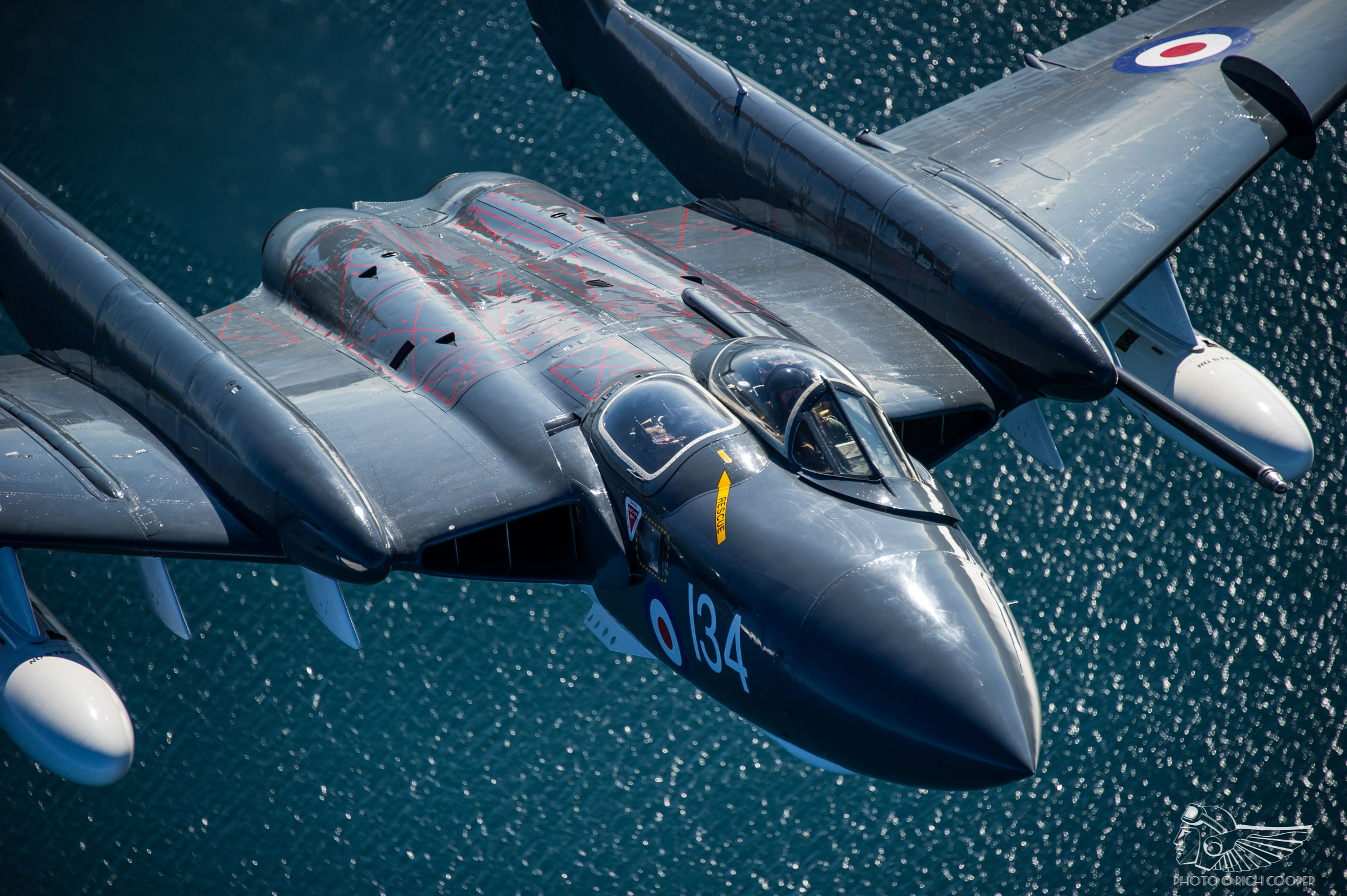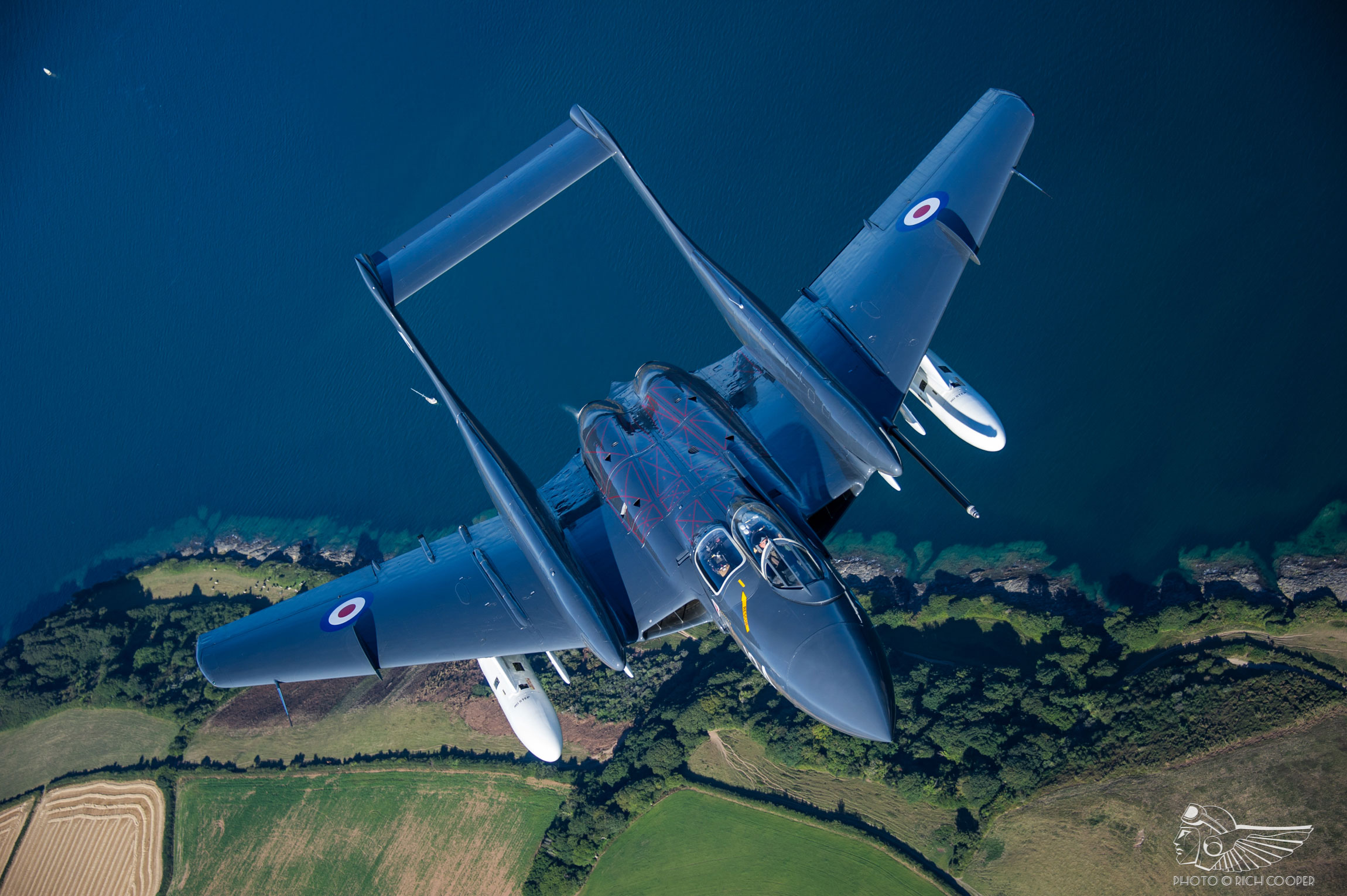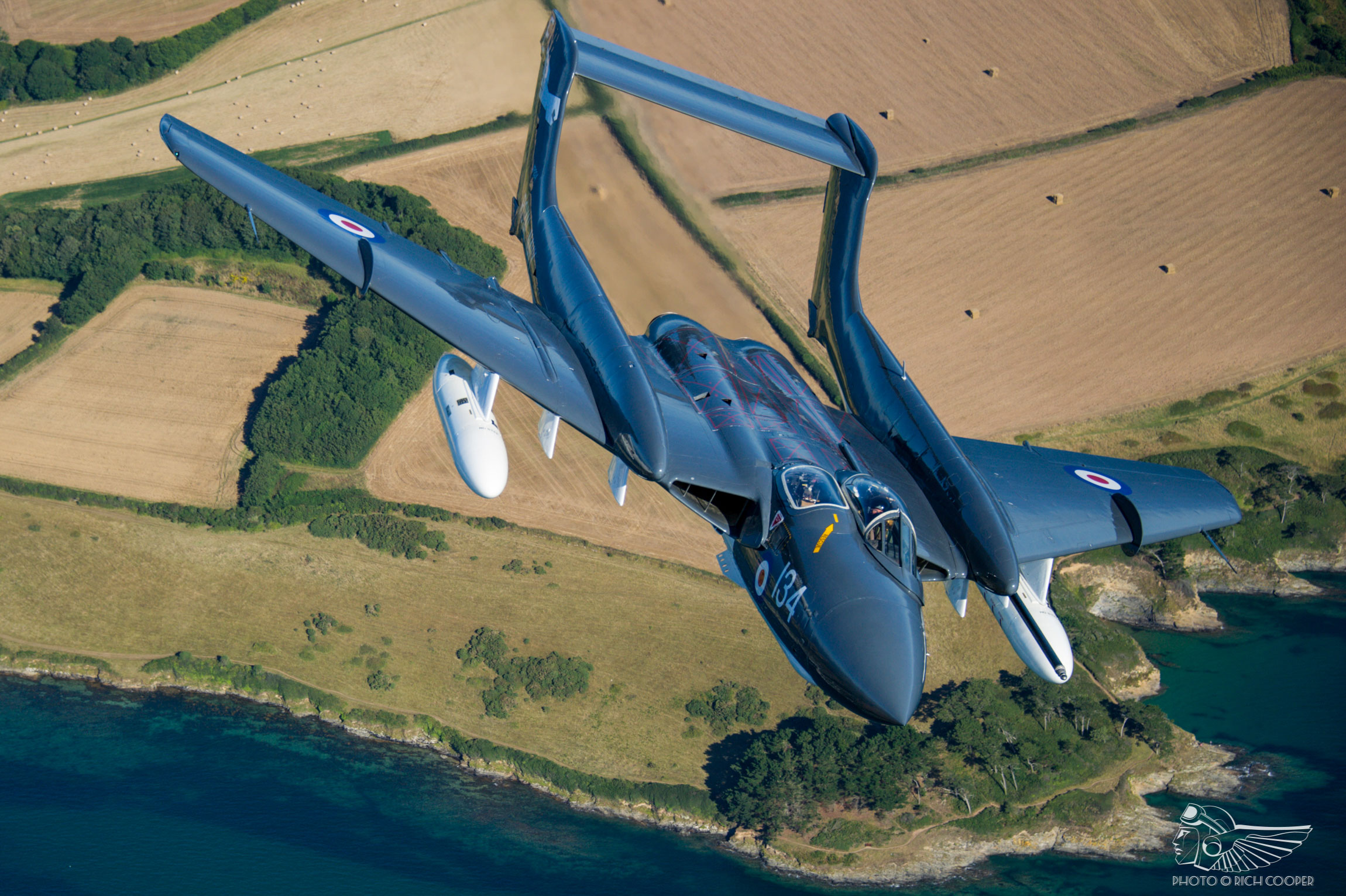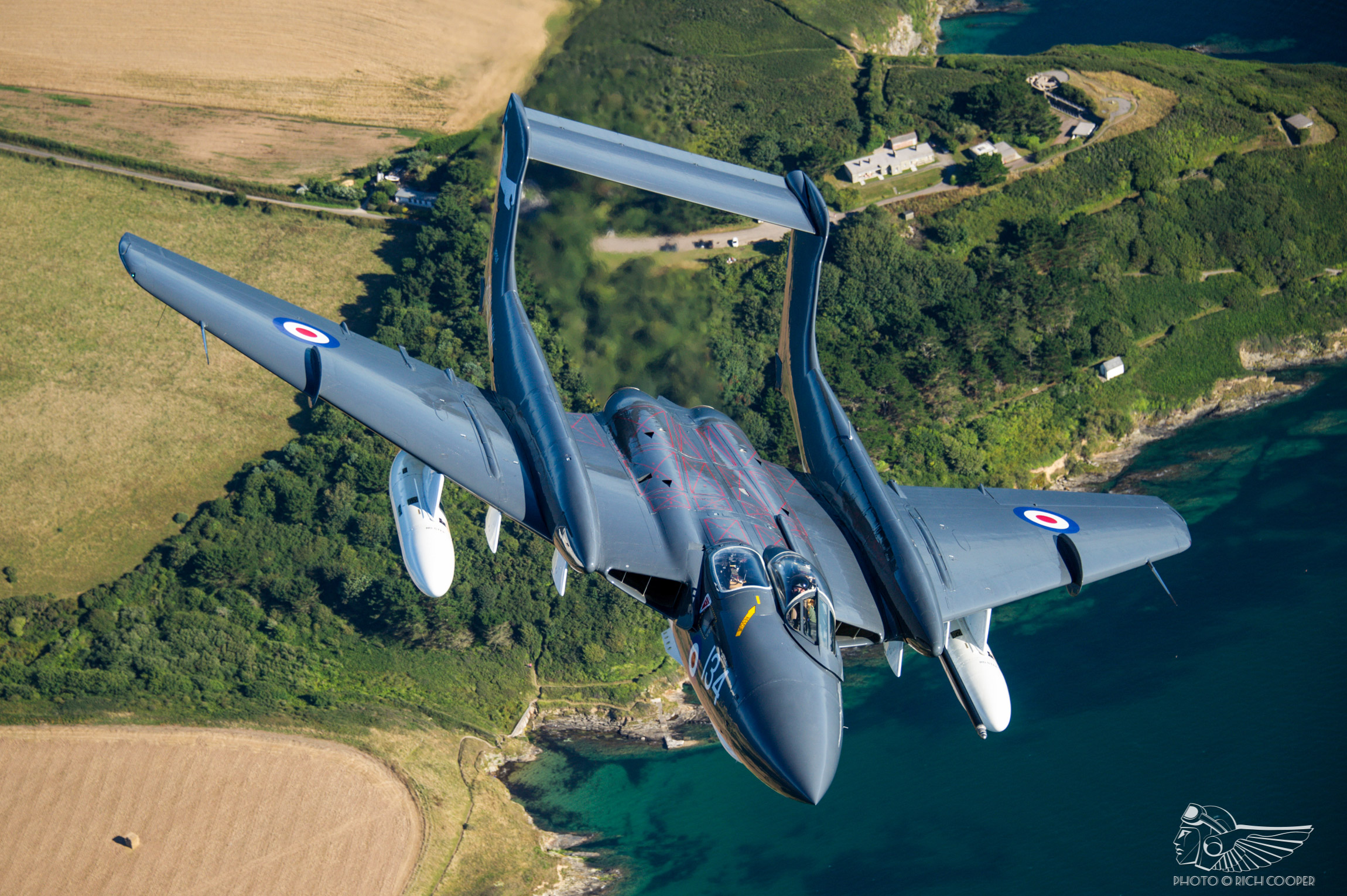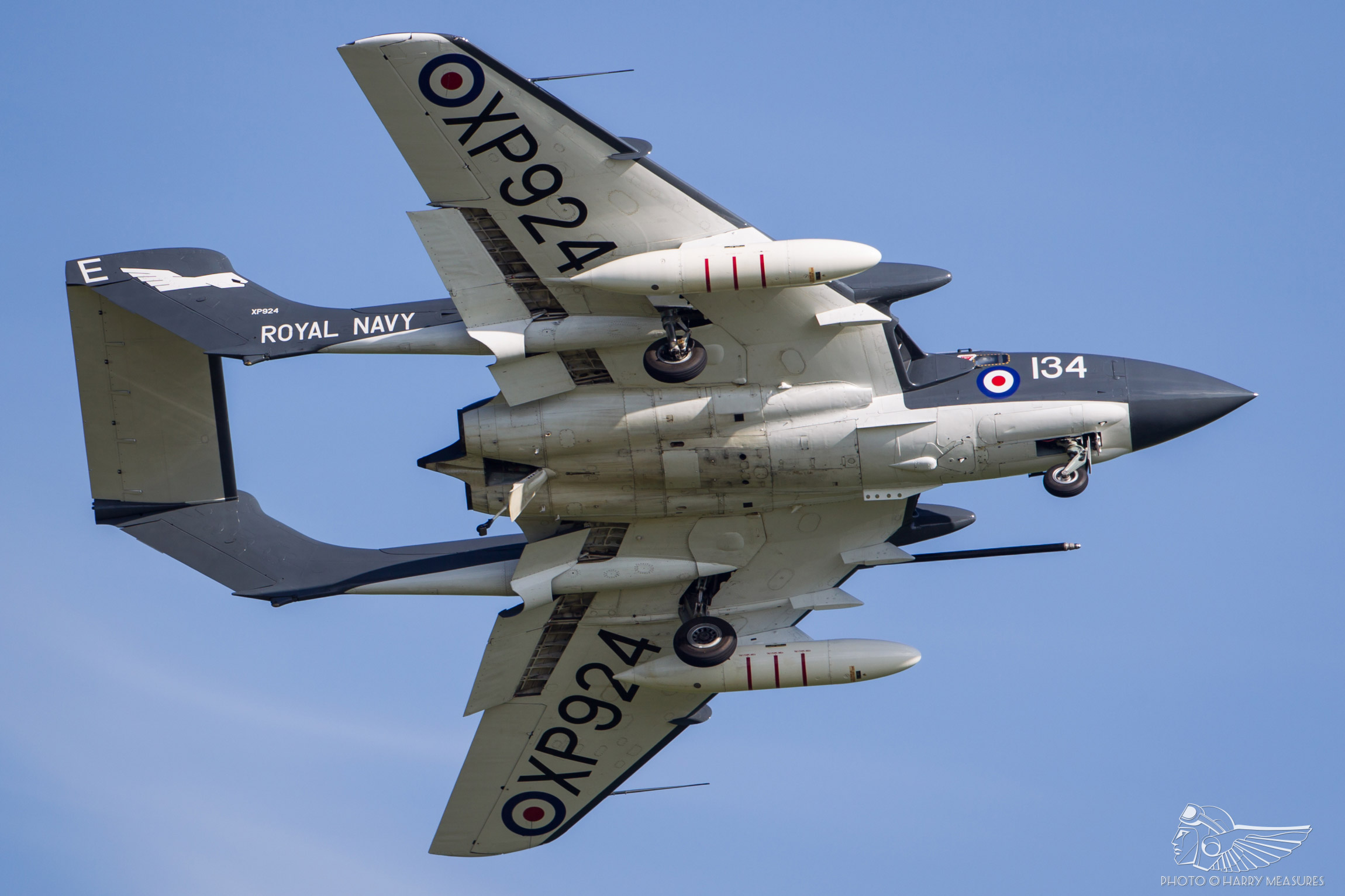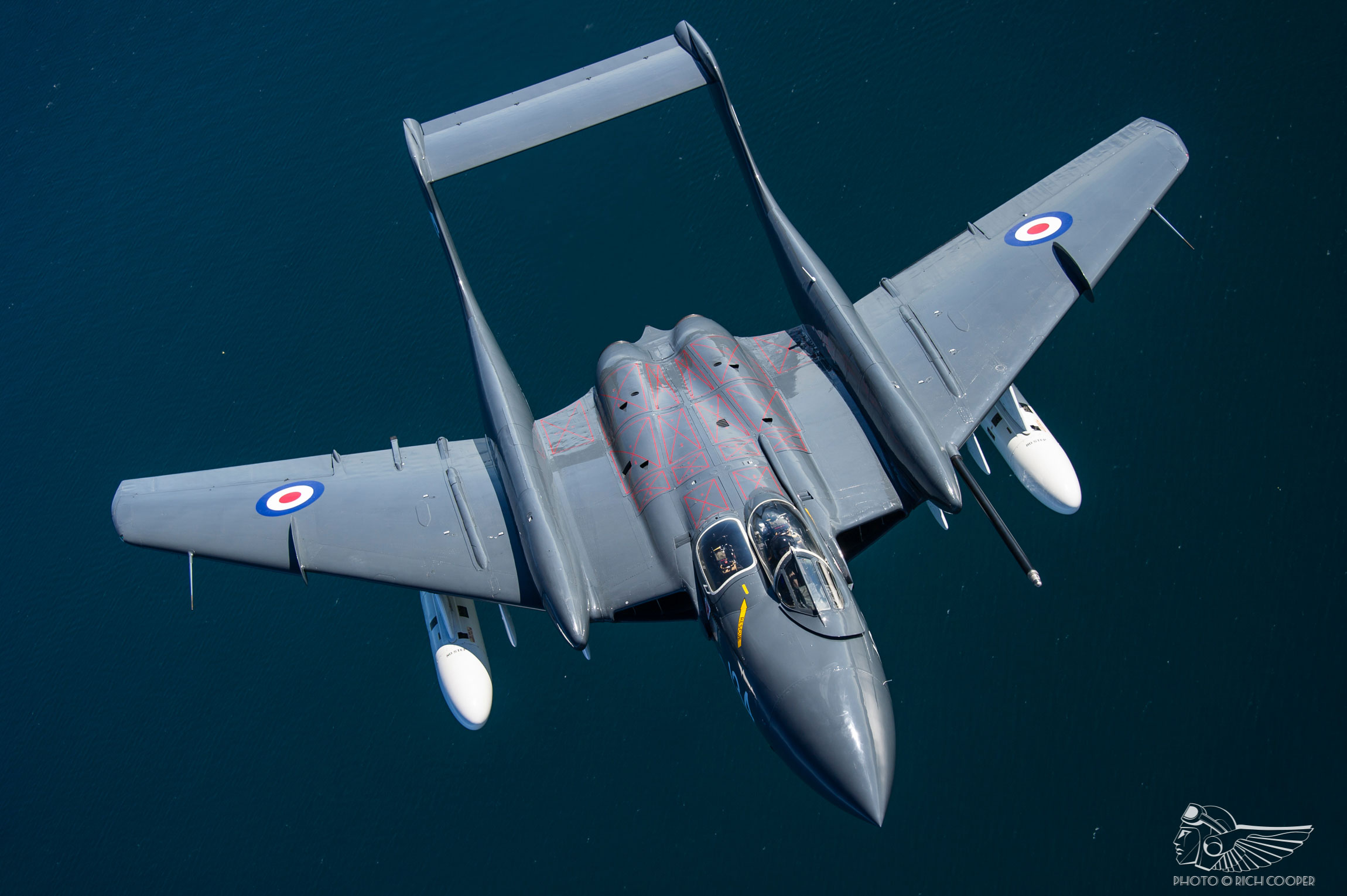On Saturday, 27 May 2017, de Havilland Sea Vixen XP924 (G-CVIX) suffered hydraulic issues following a successful air display at Duxford and its pilot, Cdr Simon Hargreaves, performed a wheels-up landing at RNAS Yeovilton. To support the aircraft’s repair and return to flight, you can visit the Navy Wings Sea Vixen Appeal 2017 web page and make a donation.
When de Havilland Sea Vixen D3 XP924 (G-CVIX) returned to flight under civilian ownership in 2000, ex-military test pilot Dan Griffith was responsible for conducting the test flying regime – here, he recounts his impressions of flying what was then the UK’s most complex civil-operated classic jet.
Manufactured by Hawker Siddeley Aviation Ltd in 1963, XP924 was one of the last Sea Vixens to enter Royal Navy service. Allocated to 899 Naval Air Squadron in 1964, the Vixen flew from RNAS Yeovilton and the aircraft carrier HMS Eagle prior to transference to Llanbedr, where it was utilised in radar test trials before conversion to D3 configuration as a drone. Its service life concluded in 1991 following a four-year stint at Llanbedr and the aircraft was later acquired by Gwyn Jones who, along with former Sea Vixen pilot Marcus Edwards, initiated the lengthy restoration to flight process and placed the aircraft on the civil register as G-CVIX.
Dan Griffith began his association with the Sea Vixen at the turn of the century, as de Havilland Aviation Ltd’s ambitious plans to restore the aircraft to flying condition reached a positive conclusion. Dan has tremendous experience in the fast-jet field, having initially cut his teeth on the Royal Air Force’s Harrier GR3s during 1(F) Squadron’s formative years with the type, accumulating over 1,200 hours on successive Harrier variants throughout his career. Stints at Edwards Air Force Base, Bedford and Boscombe Down followed, putting him at the controls of dozens of aircraft as a research and development test pilot, among them the A-7 Corsair, A-10 Thunderbolt II, F-15 Eagle, F-16 Fighting Falcon, Tornado GR.1, Jaguar GR.1 and NASA’s F-18 HARV test platform, as well as heavier multi-engine types such as the C-130 Hercules, C-141 Starlifter, C-5 Galaxy and B-52 Stratofortress. Upon leaving the military in 1996, Dan continued his career as a test pilot in the civilian world, notably performing much of the regulatory flight testing on the Airbus A380. He has also made an impression on the European airshow circuit during, displaying numerous vintage aeroplanes and classic jets over more than two decades ranging from First World War replica biplanes and triplanes to the likes of the Meteor, Hunter and Canberra.
Following Marcus Edwards’ untimely death, Dan was asked by Gwyn Jones to conduct the post-restoration Civil Aviation Authority (CAA) air testing and development flight-testing of the Sea Vixen. “It was a huge responsibility,” he reflects, “which is something that people forget, I think. It was Gwyn Jones and Marcus Edwards’ dream. The engineers had worked on it for years, and hundreds of thousands of pounds, if not more, had been poured into the restoration. It was, at the time, the most complex aeroplane that the CAA had allowed to fly on the civil register, which added its own pressure. The aircraft was going to be the sole airworthy example, and was very high profile in the aviation community as a result. That weighs on your shoulders, and you’re taking an awful lot into the air with you!” It’s a burden Dan understands well, having test flown numerous unique restorations and recreations – including the Gloster Meteor T7 and Travel Air Mystery Ship in more recent years, to name two prominent examples – but he has encountered nothing else of the Sea Vixen’s calibre in civilian life. “It’s extremely rewarding, exciting and frightening all wrapped into one!” Dan’s experiences in the fast-jet test field placed him in excellent stead to approach the test regime of the Sea Vixen – a classic jet, yes, but one “at the top end of the intermediate category, which was a moot point because it could have easily slipped into the complex category.
“The big thing with testing is to get as much information about the aircraft as possible”, he explains. For an existing type with a service record, there is an abundance of information available in this respect – flight manuals, pilots’ accounts and the like – with which to develop a comprehensive knowledge base before ever stepping into the cockpit. With the Sea Vixen having undergone extensive restoration, the preparatory stage involved an additional level of engagement. “The civilian world hadn’t really dealt with some of these types of systems, in this type of aeroplane before”, says Dan. “I went down to Bournemouth several weeks before the first flight and received a comprehensive briefing from the engineers and did a lot of ground runs and taxying. I studied the manuals, explored the flight control systems on the ground, familiarised myself with the emergency procedures and identified areas which could cause an issue during the test flight stage.”
At the start of the millennium, and pre-Vulcan, the Sea Vixen was the most complex jet to be operated in civil ownership in the UK, an accolade which brought with its own set of challenges. “The systems were fairly new to me, with the fuel system being the big thing in the Sea Vixen. If you didn’t keep on top of the manual fuel tank selection to keep the aircraft from becoming imbalanced, you could run into problems. There’s a lot of workload looking after the fuel system – dials to monitor and tank selections to be made. There were also some interesting flight control aspects to take account of, such as the changeovers in low-speed and subsonic flight. I looked at the flying qualities of the aeroplane and what affects those, I looked at the engine usage and studied the fuel system. They, to me at the time, were the big issues to grapple with before getting airborne.”
The Sea Vixen’s origins hail back to the ill-fated de Havilland DH.110, the prototype of which first flew from Hatfield aerodrome on 26 September 1951. The design was refined in subsequent years before its introduction to Fleet Air Arm service as a carrier-based fighter in July 1959. Consequently, the aircraft is an interesting juxtaposition of early jet technology – the archaic de Havilland twin boom harking back to the Vixen’s 1940s forebears – and more modern technology in the two Avon Mk.208 engines offering 25,000Ibs of thrust. “It was a very difficult aeroplane in the way things were laid out in the cockpit”, Dan recalls of his initial impressions of the Sea Vixen. “It was difficult to see the fuel switches. The whole cockpit was obviously archaic and it was a little thrown together, with an awful lot in there and a fair number of dials you didn’t really need to worry about. With experience it became reasonably easy to navigate, but stepping into the offset cockpit for the first time, it did feel a little alien in comparison with its contemporaries.”
That offset cockpit offered a challenge to jet pilots who had cut their teeth on trainers such as the Gnat and Meteor which have traditional centerline cockpit arrangements. Whilst the sensation is “a little odd the first time you taxi around”, it didn’t pose any issues to a pilot once airborne. “Where it requires attention”, Dan continues, “is on approach to land – you don’t want to put your body on the centre line like you would with conventional single-seaters, as the aircraft would end up cantered off to the right.” Another interesting aspect to Sea Vixen operation is the requirement for a Palouste air start generator, which supplies compressed air to each engine in turn and spins the engine to an appropriate RPM ready for fuel injection. “It’s quite a complicated process in modern terms, and it gave us some additional considerations when taking the aeroplane around the country as we had to ferry the Palouste around by road. You also had to have an experienced engineer on hand to switch the air pipe over to the second engine valve, and you have to have confidence in them.”
A methodical approach to test flying new aircraft saw Dan spend a number of hours conducting both low and high-speed taxy trials whilst the Sea Vixen’s paperwork was under consideration with the CAA. This enabled Dan to acclimatise himself with the Vixen’s behaviour in a ‘safe’ environment and get a feel of how the aircraft handles up to the point of take-off. Following a long-term restoration, this approach also helped affirm confidence that the aircraft’s flight controls had been connected correctly and were all in working order. “That may sound odd, but there have been aeroplanes that have got airborne and the pilots have found the controls weren’t connected correctly – people have been killed that way. The ground taxying assists with giving you confidence that everything is connected and working correctly following deep restoration and maintenance, and the understanding of how the systems work in practice. The first flight shouldn’t offer any surprises in that respect.
“The operator exposed me, if you will, to as much as they could before I took it into the air, which is exactly what you would do with a prototype during testing. By the time you get airborne, you know the aeroplane so well that you’re only focused on flying it. You’ve removed as many of the unknowns as possible before the first flight – with a complicated aeroplane like the Sea Vixen, there’s a lot going on during that first flight and anything you can take away from that workload is worthwhile.”
The day of the test flight saw a final raft of ground-based assessments prior to getting airborne for the first time, as Dan recalls. “I accelerated down the runway to about 90 knots, closed the throttle and came to a gentle braking stop, then came back the other way, this time coming up to rotate speed but no further. What I then did was to gently move the stick left and right to make sure the aircraft was trying to roll, and then gently pushed back and forward on the stick to see that the nose is starting to go in the right direction. That assured me that the aircraft was responding to stick inputs the way I expected, the brakes were working and I knew what the sensations of acceleration and deceleration would be.”
Those sensations made an impression when the Sea Vixen finally found air under her tyres for the first time in years, as Dan held the aircraft on its brakes at 80% throttle before releasing and opening the throttle to full power for take-off. “It had a massively quick acceleration”, he enthuses, “with an almost 1:1 thrust-to-weight ratio at the fuel levels we used”. At 100-110 knots, the Sea Vixen started to rotate, and it was airborne by 140, “getting off the ground like a scalded cat and climbing like a homesick angel with its extremely powerful engines”. It easily achieved its operational climb speed of 370 knots, albeit Dan found it climbed to 10,000ft without any difficulty at a conservative 250 knots.
The first flight was a 25-30 minute general handling sortie with a sequence of pitches, rolls, turn reversals, engine management tests, flight system monitoring and so on for familiarisation purposes. Dan remembers the Sea Vixen being “very impressive” during that first flight, surmising that you can glean the majority of your opinion of an aircraft during the first ten minutes of flight testing, with the subsequent five to ten hours of testing essentially affirming those initial impressions and delivering concrete flight data. “It felt like a big, go-to-war, powerful aeroplane – not too dissimilar to the Phantom or Tornado class of jet, from the general in-cockpit feel. The cockpit may have been archaic, but performance-wise it was more akin to a more modern jet within that bracket. It’s quite overpowering in some respects.
“The general technique is to go up, fly around, start bringing it back to approach speed and get an idea of where you’d start to lose control of the aircraft at slower speed, without taking it to the stall – you don’t go to the stall in the first flight in any aeroplane”, Dan continues. “Then you put the flaps and gear down and bring the speed back to that mushy feel again in the landing configuration. That tells you roughly what it’s going to be like on the approach, and gives you the speed at which point you begin to lose control. Depending on weight and configuration, you’d stall at between 90 and 100 knots in the Sea Vixen, and it tended to be quite a benign stall, albeit the flight manual prohibited full stalls and I never took it beyond the initial buffet. The nose drops away but it wasn’t aggressive, certainly none of the torque-based flicking you might find with piston aeroplanes.”
Dan describes a key element of the initial test profile as a means of assuring yourself that you get to safely land the aircraft, hence the incremental low-speed handling and stall tests to bottom out a conservative landing speed – comprehensive slow-speed assessments followed during the subsequent longer test flights. “This approach gives you the correct numbers for the early stages of the stall, and you add a factor of 30% on top of that to give you a comfortable approach speed”, Dan explains, “which is vital for that first flight and knowing that you’re capable of safely bringing the aircraft back down. Yes, the manuals give you the approach speed but you don’t know if the airspeed is registering accurately – you may have an airspeed indication system error and could stall 20 knots above that speed. Approach speed is normally 1.3x the stall speed, and you land at 1.1-1.2x the stall speed.”
Dan’s range of handling tests identified one of the Sea Vixen’s most notable nuances in its slow-speed instability, resultant due to the aircraft’s low-speed control system ‘gear change’, which comes into effect during the approach at speeds of 120-130 knots (weight and flap dependent). Dan explains the practical implications of the system: “In the landing configuration, the flight control system automatically changes the gains of your stick compared with the elevator. It makes it much more sensitive, but the system wasn’t quite developed to its fullest extent. I remember getting airborne thinking, ‘Okay… This is very pitch unstable’. It was terribly unstable on approach, pitching up and down three or four degrees all the way. I was thinking back to the Sea Vixen’s operational role, and the guys landing these things on carriers at night, which gave me the assumption that it would have beautiful low-speed control. Shortly after the first flight I telephoned Jonathan Whaley, who has 2,000 hours on Sea Vixens, and said, ‘Look, this aeroplane is very unstable in pitch on approach, what’s wrong with it?’ He said, ‘That’s exactly how it is!’
“It was eye opening early on,” Dan continues, “being very twitchy and not easy to stabilise on approach. The first landing was tricky because I wasn’t expecting it and it takes a bit of time to learn how to fly through it. You’d have to make a control input using the stick and let it settle, so to speak, rather than over-controlling it and correcting every little error. It’s what you call an open loop, where you monitor control inputs and make small adjustments depending on the outcome of the previous input.”
The gear change also occurs at higher subsonic speeds above 500 knots, as Dan discovered during subsequent test flights that pushed the aircraft closer to the fringes of its maximum capabilities, making it something of a handful at the opposing ends of the flight envelope. “You were slightly misled compared to other similar aeroplanes due to the flight system changeovers. It felt like the oscillations in pitch were getting stronger the faster you went. It became really noticeable at the 540-560 knot range, and the first time I brought the speed up that high I ended up closing the throttle and bringing the speed right back. That was a very tense moment because I had the feeling it could just become unstable enough to depart as I approached the maximum speed of 610 knots. It may never have departed on me, but it gave me that impression and a level of concern that I didn’t go to that speed again unless I had to as part of the air-testing programme – it was beyond my comfort factor. It’s all to do with the shockwaves moving off the aeroplane, particularly prevalent with the Sea Vixen given its large wing structure and tail plane, which likely made it more susceptible.”
At the mid-level speed range, however, the Sea Vixen is a real sweetie with no notable vices. An optimum roll rate can be achieved at around 370 knots where it “goes like a dingbat”, and it is capable of all standard aerobatic figures. It was an ideal ‘act’, then, for the air display environment that the aircraft went on to thrive in from 2001 to the present day. Indeed, Dan had the distinction of piloting G-CVIX during its first display season back in 2001, débuting at the Duxford Spring Air Show in May. “The Sea Vixen is so over-powered, it was one of the only aeroplanes that I had to actually think about throttle usage during a display”, he says. “Most aeroplanes you tend to set a display power – max continuous thrust in jets, for example – and tend to manouevre to kill off energy. With the Sea Vixen, I had to use the throttle all the time, otherwise I’d be far too fast to be able to reposition tightly”.
One of the Sea Vixen’s traits is its ability to transition from 130 to 550 knots “almost instantaneously”, permitting a display speed range of 400 knots. “That made it a very exciting aircraft to display”, Dan recalls, and the result was a sequence that looked far more aggressive than it actually was, with high-speed passes leading to tight turns as the combination of air brake and induced drag from the aircraft’s 648 square foot wing area naturally bleeding the speed off in the turn.
“What I tend to do when putting an aeroplane like this into an airshow environment is to display for the crowd and the photographers. I try to keep relatively close and put as many angles into the routine as possible. That’s my general philosophy for display flying; I don’t fly loops, rather half-Cubans, and my gate heights and speeds are different to some people as a result. Once you know the minimum speed needed for a half-Cuban, you know what speed you need to be for any vertical figures, such as rolls or obliques. I would position behind the crowd and run in at the maximum speed I’d dare come in at, close the throttle and enter a slower speed display that comes in on the 45 degree axis, the 90 degree axis, the A-axis, top side, belly-up and so on. I tried to build that into an eight minute display to suit the respective venues”.
His standout displays included the very first public outing at Duxford and a private solo before a crowd of former Sea Vixen pilots at Yeovilton in September 2001. “I don’t know what happened during that display, but it was absolutely electric. I knew the aeroplane well, having flown it for six to seven months, and it just all came together.” Indeed, Dan cites the Sea Vixen as “the most exhilarating aeroplane” he has flown in the airshow environment, a unique classic jet which has left a lasting impression on him for many years hence. His enthusiasm and affection for the ‘Foxy Lady’ shines through more than a decade after his last flight in the aircraft.
Whilst Dan no longer flies the Sea Vixen, the aircraft has remained a popular – if elusive – performer on the UK airshow circuit since 2001. Under the care of Naval Aviation Ltd and the Fly Navy Heritage Trust at RNAS Yeovilton, Somerset, G-CVIX will hopefully (repairs pending) continue to represent an important era of classic jet development by thrilling airshow crowds for years to come.
![]()



